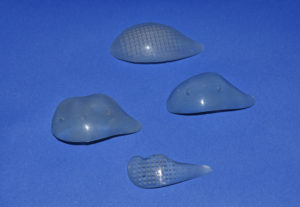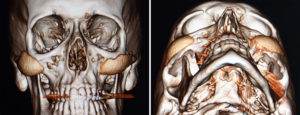
But cheek implants have several features that make them different than their close cousin, the chin implant. The implant sits on a curved bone surface that is not horizontal in orientation. The zygomatic bone is angled more obliquely rather than horizontal, making implant insertion an up and back maneuver rather than a purely horizontal one. Of even greater significance is that most cheek implants are bilateral, there is an implant needed for both sides.
The bilateral nature of cheek implants and the topography of the bone site they occupy creates an increased risk of aesthetic complications. The most common cheek implant complication is asymmetry. Getting the implants to be perfectly positioned the same on both sides is not an assured outcome for a variety of reasons. Few patients have perfectly symmetric zygomatic bones and, when standard symmetrically shaped implants are used, this natural bony asymmetry may become magnified.
But more importantly the surgical placement of cheek implants represents an independent event for each side. The two sides of the cheeks can not be directly compared and are only seen through small intraoral incisions during surgery. It is not like attaching the implants on a skeletal model, complete visual access to the whole implant can not be seen. Thus getting a perfect implant position on the bone that is seen as identical on both sides is uncommon.

Cheek implants are usually done as a pair which creates an increased risk of asymmetry over that of a single implant procedure like chin augmentation. Small changes in cheek implant position, often as small as a few millimeters, can create noticeable cheek shape differences. Patents should be aware of these risks and that revision surgery for cheek implant respositioning is not a rare occurrence.
Dr. Barry Eppley
Indianapolis, Indiana


